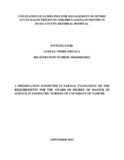| dc.description.abstract | Background: Malnutrition is responsible for 35% of deaths among children under five years of age globally (Black et al., 2008). It causes 2.8 million deaths in children per year (WHO/FAO, 2014). The prevalence of severe acute malnutrition in Kenya is estimated to be 6% (MoH, 2009). In Busia County Referral Hospital case fatality rate for children with severe acute malnutrition in 2014 was 26% (DHIS Kenya). World Health Organization (WHO) has developed guidelines for the management of severe acute malnutrition in children (WHO, 1999). The use of these guidelines in treatment of children with malnutrition reduces mortality related to malnutrition.
Objectives: The objective of the study was to assess the utilization of guidelines for management of severe acute malnutrition in children aged 6-59 months in Busia County Referral Hospital.
Methods: This was cross-sectional, descriptive study. Participants were recruited from the paediatric ward. Purposive sampling was used to select the study sample. A checklist was used to check documentation of guidelines for management of malnutrition in children from the in-patient files and implementation by the caretakers. Key informant interviews were conducted to obtain data on the supply of essential nutritional commodities in the study sites involved in the care of children. Descriptive data was analysed using mean, mode and median. Findings were presented in form of frequency tables and bar charts. An overall guidelines utilization scoring tool was developed and used to rate the overall utilization of the guidelines.
Results: A total of ninety six (96) participants were recruited for the study. The mean age of the participants was 21.85 months. There was significantly higher proportion of children with MUAC less than 11.5cm among 6 to 12 months 20(69.0%) [OR=9.26; 95%CI=2.82-30.39; P<0.001] and 13 to 24 months 16(44.4%) [OR=3.33; 95%CI=1.10-10.09; P=0.033] compared to those aged 25 to 59 months 6(19.4%). Mean weight had increased from 7.97Kg at admission to 8.45Kg at 7 days and this differences was significant (p<0.0001) after paired samples t test was computed. The average utilization of the guidelines was 86.4%.
Conclusion and recommendations: Guidelines for management of severe acute malnutrition are adequately utilized in Busia County Referral Hospital. Commodities needed for management of children with severe acute malnutrition, particularly F75 and F100 are available at the hospital. Periodic training of all health workers involved in the care of children with severe acute malnutrition is recommended to ensure optimum utilization of the guidelines for management of severe acute malnutrition. | en_US |

